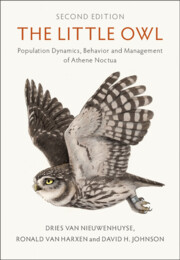Book contents
- The Little Owl
- The Little Owl
- Copyright page
- Contents
- Foreword
- Preface
- Acknowledgements
- Executive Summary
- Chapter 1 Introduction: Framework
- Chapter 2 History and Traditions
- Chapter 3 Fossil Evidence, Taxonomy and Genetics
- Chapter 4 Morphology and Body Characteristics
- Chapter 5 Distribution, Population Estimates and Trends
- Chapter 6 Habitat
- Chapter 7 Diet
- Chapter 8 Breeding Season
- Chapter 9 Behavior
- Chapter 10 Population Regulation
- Chapter 11 Management and Conservation
- Chapter 12 Research Priorities
- References
- Index
Chapter 5 - Distribution, Population Estimates and Trends
Published online by Cambridge University Press: 29 September 2023
- The Little Owl
- The Little Owl
- Copyright page
- Contents
- Foreword
- Preface
- Acknowledgements
- Executive Summary
- Chapter 1 Introduction: Framework
- Chapter 2 History and Traditions
- Chapter 3 Fossil Evidence, Taxonomy and Genetics
- Chapter 4 Morphology and Body Characteristics
- Chapter 5 Distribution, Population Estimates and Trends
- Chapter 6 Habitat
- Chapter 7 Diet
- Chapter 8 Breeding Season
- Chapter 9 Behavior
- Chapter 10 Population Regulation
- Chapter 11 Management and Conservation
- Chapter 12 Research Priorities
- References
- Index
Summary
In this chapter, we examine aspects of distribution and population in the Little Owl for its global range which covers 78 countries. Recent publications give an overview of population numbers and short- and long-term breeding population and breeding distribution trends for the EU28 and for continental Europe. The European Union (EU28) Red List assessments are based principally on the official data reported by EU Member States to the European Commission under Article 12 of the Birds Directive. In addition, population status and trends are assessed at the EU level. Data outside the European continent are obtained from individual publications. In very general terms, all cumulative data suggests that the global distribution of the Little Owl has increased in 12 countries, decreased in 10, remained unchanged in 25 or was insufficient for determination in 31 countries. For population numbers, the data suggests that the number of owls increased in 12 countries, decreased in 10, remained unchanged in 23 or was insufficient for determination in 33 countries. The global distribution and some limiting factors like latitude and elevation, are mapped, as well as European population numbers and short- and long-term trends. For each country we focus on the population estimates for currently existing populations and present distribution maps when available.
- Type
- Chapter
- Information
- The Little OwlPopulation Dynamics, Behavior and Management of <I>Athene noctua</I>, pp. 146 - 238Publisher: Cambridge University PressPrint publication year: 2023



